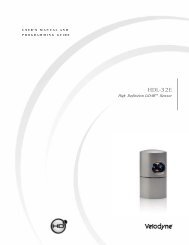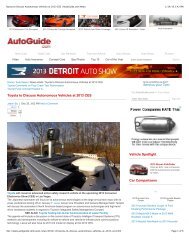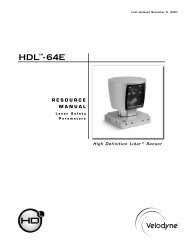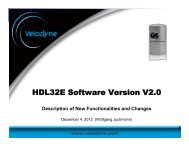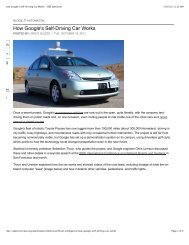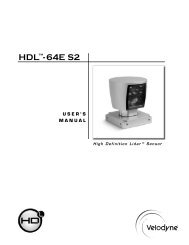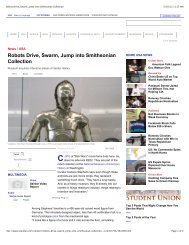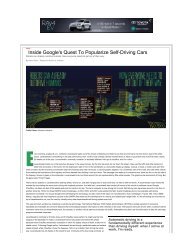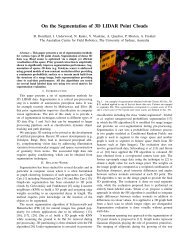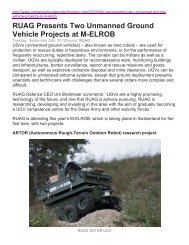Driverless Vehicles Make Inroads in Military - Velodyne Lidar
Driverless Vehicles Make Inroads in Military - Velodyne Lidar
Driverless Vehicles Make Inroads in Military - Velodyne Lidar
Create successful ePaper yourself
Turn your PDF publications into a flip-book with our unique Google optimized e-Paper software.
model of <strong>in</strong>cremental improvements, currently<br />
mov<strong>in</strong>g to semiautonomous technology with<br />
plans to, at some po<strong>in</strong>t, offer full autonomy if<br />
people really want it. Many automakers still <strong>in</strong>sist<br />
that the goal is not unmanned driv<strong>in</strong>g, but<br />
assisted driv<strong>in</strong>g that relieves the pressure from<br />
humans when they need it. But, with statistics<br />
show<strong>in</strong>g that young people are ga<strong>in</strong><strong>in</strong>g their licenses<br />
at an <strong>in</strong>creas<strong>in</strong>gly older age and less and<br />
less are choos<strong>in</strong>g to own a car, it seems that driv<strong>in</strong>g<br />
has become an irritat<strong>in</strong>g distraction for many.<br />
For some, it takes away<br />
valuable time from social<br />
media and Internet<br />
brows<strong>in</strong>g <strong>in</strong> general —<br />
the grow<strong>in</strong>g addiction of<br />
this second decade of the<br />
21st century.<br />
Google Dom<strong>in</strong>ation<br />
So, is Google ahead of<br />
the automakers Through<br />
<strong>Driverless</strong> Car HQ’s own<br />
research, mostly assisted<br />
by Google’s own search<br />
eng<strong>in</strong>e, we have counted<br />
28 California-plated<br />
self-driv<strong>in</strong>g cars, <strong>in</strong>clud<strong>in</strong>g<br />
eight Toyota Prius<br />
vehicles and 22 Lexus<br />
RX450hs, <strong>in</strong> addition to several <strong>in</strong> Nevada. So<br />
common are they that many commuters around<br />
the Bay Area have <strong>in</strong>formed <strong>Driverless</strong> Car HQ<br />
reporters that they see the Google driverless cars<br />
on a weekly basis.<br />
In August Google announced on its official<br />
blog that its vehicles had completed more than<br />
300,000 miles on public roads. In September<br />
Google had completed more than 50,000<br />
miles consecutively without any safety critical<br />
human <strong>in</strong>tervention. Now, with 30 vehicles on<br />
the road and a fleet that is rapidly expand<strong>in</strong>g,<br />
the quantity of miles driven is set to balloon.<br />
<strong>Driverless</strong> Car HQ expects Google to reach the<br />
magic million-mile figure at some po<strong>in</strong>t around<br />
mid 2013. This number is significant, given the<br />
claim of Stanford’s Bryant Walker Smith that<br />
Google would need 727,000 miles without human<br />
<strong>in</strong>tervention to demonstrate that there is<br />
99 percent confidence that their vehicle will be<br />
Automakers have yet to publicly demonstrate the level of autonomy shown <strong>in</strong> DARPA’s 2007<br />
Urban Challenge. Photo courtesy DARPA.<br />
safer than a human be<strong>in</strong>g. None of the automakers<br />
have released figures on miles tested on<br />
public roads, although Audi and Cont<strong>in</strong>ental<br />
needed to achieve at least 10,000 miles to satisfy<br />
Nevada’s licens<strong>in</strong>g requirements.<br />
Bridg<strong>in</strong>g Technology Gaps<br />
<strong>Lidar</strong> seems to be Google’s silver bullet <strong>in</strong> achiev<strong>in</strong>g<br />
these advances so quickly. Many observers see<br />
lidar as the gold-standard technology if you want<br />
to achieve as close as possible<br />
to 100 percent confidence<br />
of object recognition.<br />
Of the automakers,<br />
<strong>Driverless</strong> Car HQ has<br />
seen <strong>Velodyne</strong>’s sp<strong>in</strong>n<strong>in</strong>g<br />
lidar on GM and Toyota<br />
vehicles (for more <strong>in</strong>formation,<br />
see Page 16 of<br />
the w<strong>in</strong>ter 2012 Mission<br />
Critical: Sensors issue).<br />
Audi and Cont<strong>in</strong>ental are<br />
likely us<strong>in</strong>g German company<br />
Ibeo’s much smaller<br />
lidar units or similar sensors.<br />
There have been some impressive<br />
results with the<br />
vision-based systems from<br />
Mercedes and BMW, but<br />
it is clear that the technical gap to fully autonomous<br />
driv<strong>in</strong>g cannot currently be bridged us<strong>in</strong>g<br />
vision alone. There may well be breakthroughs <strong>in</strong><br />
this area <strong>in</strong> the next few years, but at the moment<br />
anyone that is serious about fully autonomous<br />
functionality has to be us<strong>in</strong>g a lidar-based system.<br />
In many ways the public progress announced by<br />
the automakers has been impressive, with selfpark<strong>in</strong>g<br />
Audis and Toyotas fitted with <strong>in</strong>telligent<br />
transportation system technology travel<strong>in</strong>g<br />
autonomously around the company’s test track.<br />
Mercedes, Volvo and BMW are all on the cusp of<br />
releas<strong>in</strong>g semiautonomous technology which will<br />
handle a high proportion of the driv<strong>in</strong>g workload<br />
<strong>in</strong> certa<strong>in</strong> prescribed driv<strong>in</strong>g environments,<br />
either at low speed when congested or at high<br />
speed on freeways.<br />
But, and it is a big but, the automakers have not<br />
demonstrated anyth<strong>in</strong>g publicly that approaches<br />
MISSION CRITICAL • May 2013 19




